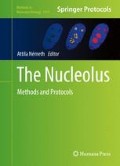Abstract
The nuclear distribution of eu- and heterochromatin is nonrandom, heterogeneous, and dynamic, which is mirrored by specific spatiotemporal arrangements of histone posttranslational modifications (PTMs). Here we describe a semiautomated method for the analysis of histone PTM localization patterns within the mammalian nucleus using confocal laser scanning microscope images of fixed, immunofluorescence stained cells as data source. The ImageJ-based process includes the segmentation of the nucleus, furthermore measurements of total fluorescence intensities, the heterogeneity of the staining, and the frequency of the brightest pixels in the region of interest (ROI). In the presented image analysis pipeline, the perinucleolar chromatin is selected as primary ROI, and the nuclear periphery as secondary ROI.
Access this chapter
Tax calculation will be finalised at checkout
Purchases are for personal use only
References
de Wit E, De Laat W (2012) A decade of 3C technologies: insights into nuclear organization. Genes Dev 26:11–24. doi:10.1101/gad.179804.111
Bickmore WA (2013) The spatial organization of the human genome. Annu Rev Genomics Hum Genet 14:67–84. doi:10.1146/annurev-genom-091212-153515
Bickmore WA, van Steensel B (2013) Genome architecture: domain organization of interphase chromosomes. Cell 152:1270–1284. doi:10.1016/j.cell.2013.02.001
Dekker J, Marti-Renom MA, Mirny LA (2013) Exploring the three-dimensional organization of genomes: interpreting chromatin interaction data. Nat Rev Genet 14:390–403. doi:10.1038/nrg3454
Rivera CM, Ren B (2013) Mapping human epigenomes. Cell 155:39–55. doi:10.1016/j.cell.2013.09.011
Tanay A, Cavalli G (2013) Chromosomal domains: epigenetic contexts and functional implications of genomic compartmentalization. Curr Opin Genet Dev 23:197–203. doi:10.1016/j.gde.2012.12.009
Sexton T, Cavalli G (2015) The role of chromosome domains in shaping the functional genome. Cell 160:1049–1059. doi:10.1016/j.cell.2015.02.040
Furlan-Magaril M, Várnai C, Nagano T, Fraser P (2015) 3D genome architecture from populations to single cells. Curr Opin Genet Dev 31:36–41. doi:10.1016/j.gde.2015.04.004
Naumova N, Imakaev M, Fudenberg G et al (2013) Organization of the mitotic chromosome. Science 342:948–953. doi:10.1126/science.1236083
Phillips-Cremins JE, Sauria MEG, Sanyal A et al (2013) Architectural protein subclasses shape 3d organization of genomes during lineage commitment. Cell 153:1281–1295. doi:10.1016/j.cell.2013.04.053
van Steensel B, Dekker J (2010) Genomics tools for unraveling chromosome architecture. Nat Biotechnol 28:1089–1095. doi:10.1038/nbt.1680
Cremer T, Cremer M, Hübner B et al (2015) The 4D nucleome: evidence for a dynamic nuclear landscape based on co-aligned active and inactive nuclear compartments. FEBS Lett 589:2931–2943. doi:10.1016/j.febslet.2015.05.037
Even-Faitelson L, Hassan-Zadeh V, Baghestani Z, Bazett-Jones DP (2016) Coming to terms with chromatin structure. Chromosoma 125:95. doi:10.1007/s00412-015-0534-9
Lakadamyali M, Cosma MP (2015) Advanced microscopy methods for visualizing chromatin structure. FEBS Lett 589:3023–3030. doi:10.1016/j.febslet.2015.04.012
Guelen L, Pagie L, Brasset E et al (2008) Domain organization of human chromosomes revealed by mapping of nuclear lamina interactions. Nature 453:948–951. doi:10.1038/nature06947
Németh A, Conesa A, Santoyo-Lopez J et al (2010) Initial genomics of the human nucleolus. PLoS Genet 6:e1000889. doi:10.1371/journal.pgen.1000889
van Koningsbruggen S, Gierlinski M, Schofield P et al (2010) High-resolution whole-genome sequencing reveals that specific chromatin domains from most human chromosomes associate with nucleoli. Mol Biol Cell 21:3735–3748. doi:10.1091/mbc.E10-06-0508
Wijchers PJ, Geeven G, Eyres M et al (2015) Characterization and dynamics of pericentromere-associated domains in mice. Genome Res 25:958–969. doi:10.1101/gr.186643.114
Bai B, Yegnasubramanian S, Wheelan SJ, Laiho M (2014) RNA-Seq of the nucleolus reveals abundant SNORD44-derived small RNAs. PLoS One 9:e107519. doi:10.1371/journal.pone.0107519.s004
Bai B, Liu H, Laiho M (2014) Small RNA expression and deep sequencing analyses of the nucleolus reveal the presence of nucleolus-associated microRNAs. FEBS Open Bio 4:441–449. doi:10.1016/j.fob.2014.04.010
Caudron-Herger M, Pankert T, Seiler J et al (2015) Alu element-containing RNAs maintain nucleolar structure and function. EMBO J 34:2758, doi: 10.15252/embj.201591458
Andersen JS, Lam YW, Leung AKL et al (2005) Nucleolar proteome dynamics. Nature 433:77–83. doi:10.1038/nature03207
Moore HM, Bai B, Boisvert F-M et al (2011) Quantitative proteomics and dynamic imaging of the nucleolus reveal distinct responses to UV and ionizing radiation. Mol Cell Proteomics 10:M111.009241. doi:10.1074/mcp.M111.009241
Dillinger S, Garea AV, Deutzmann R, Németh A (2014) Analysis of histone posttranslational modifications from nucleolus-associated chromatin by mass spectrometry. Methods Mol Biol 1094:277–293. doi:10.1007/978-1-62703-706-8_22
Zhang W, Li J, Suzuki K et al (2015) Aging stem cells. A Werner syndrome stem cell model unveils heterochromatin alterations as a driver of human aging. Science 348:1160–1163. doi:10.1126/science.aaa1356
Hayashi-Takanaka Y, Yamagata K, Wakayama T et al (2011) Tracking epigenetic histone modifications in single cells using Fab-based live endogenous modification labeling. Nucleic Acids Res 39:6475–6488. doi:10.1093/nar/gkr343
Ronneberger O, Baddeley D, Scheipl F et al (2008) Spatial quantitative analysis of fluorescently labeled nuclear structures: problems, methods, pitfalls. Chromosome Res 16:523–562. doi:10.1007/s10577-008-1236-4
Acknowledgements
This work was supported by the DFG SFB960 program.
Author information
Authors and Affiliations
Corresponding authors
Editor information
Editors and Affiliations
Rights and permissions
Copyright information
© 2016 Springer Science+Business Media New York
About this protocol
Cite this protocol
Dillinger, S., Németh, A. (2016). Quantitative Immunofluorescence Analysis of Nucleolus-Associated Chromatin. In: Németh, A. (eds) The Nucleolus. Methods in Molecular Biology, vol 1455. Humana Press, New York, NY. https://doi.org/10.1007/978-1-4939-3792-9_5
Download citation
DOI: https://doi.org/10.1007/978-1-4939-3792-9_5
Published:
Publisher Name: Humana Press, New York, NY
Print ISBN: 978-1-4939-3790-5
Online ISBN: 978-1-4939-3792-9
eBook Packages: Springer Protocols

